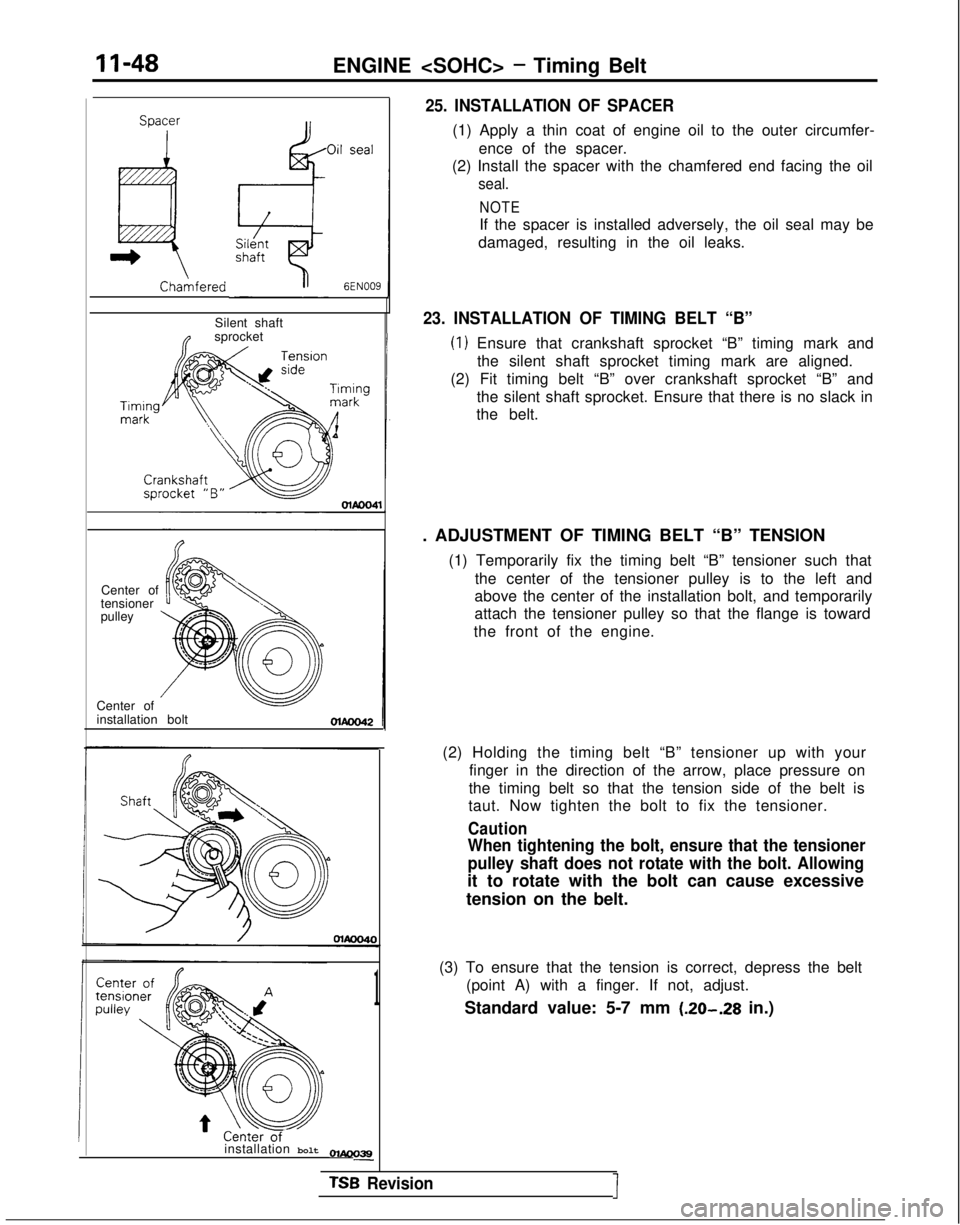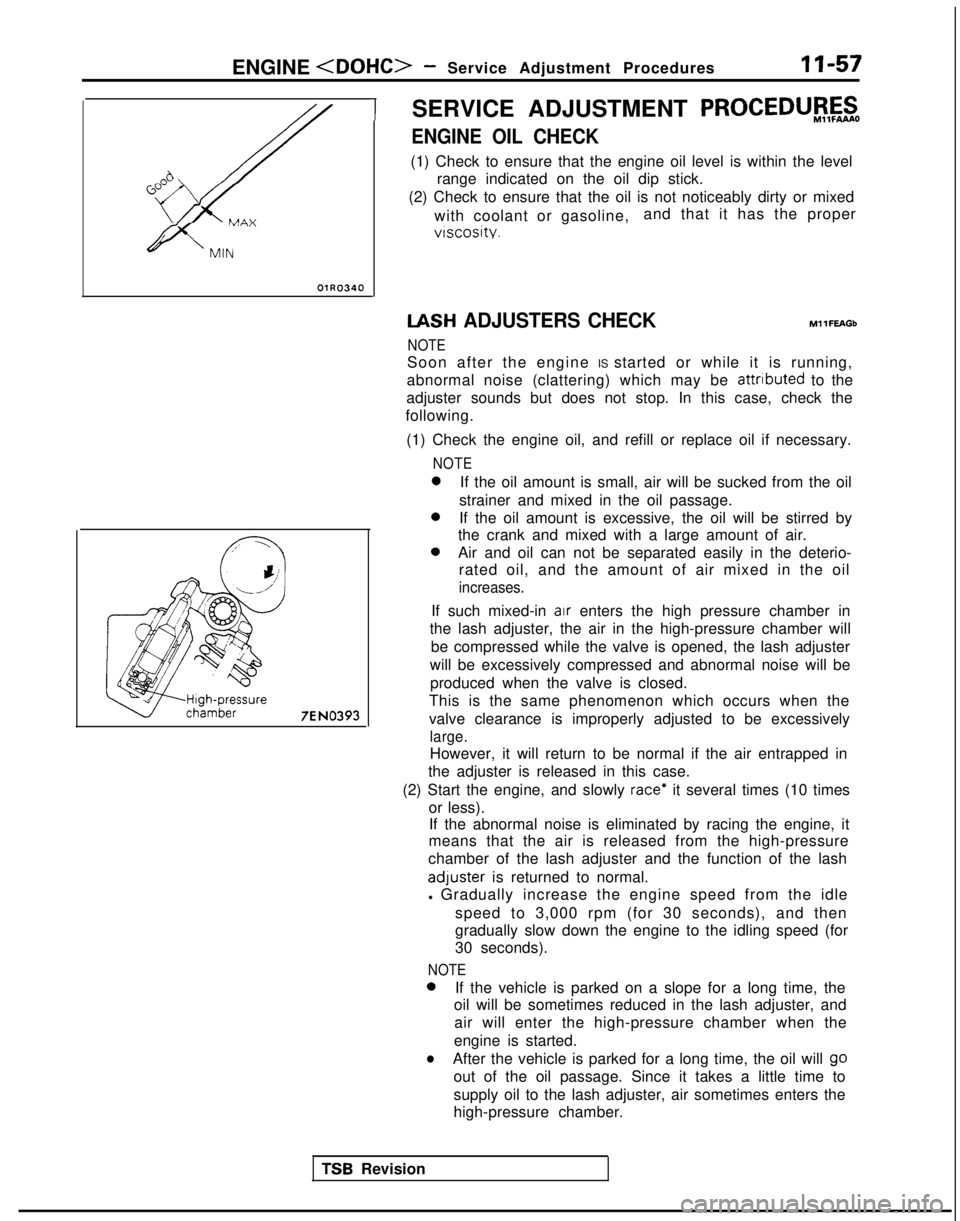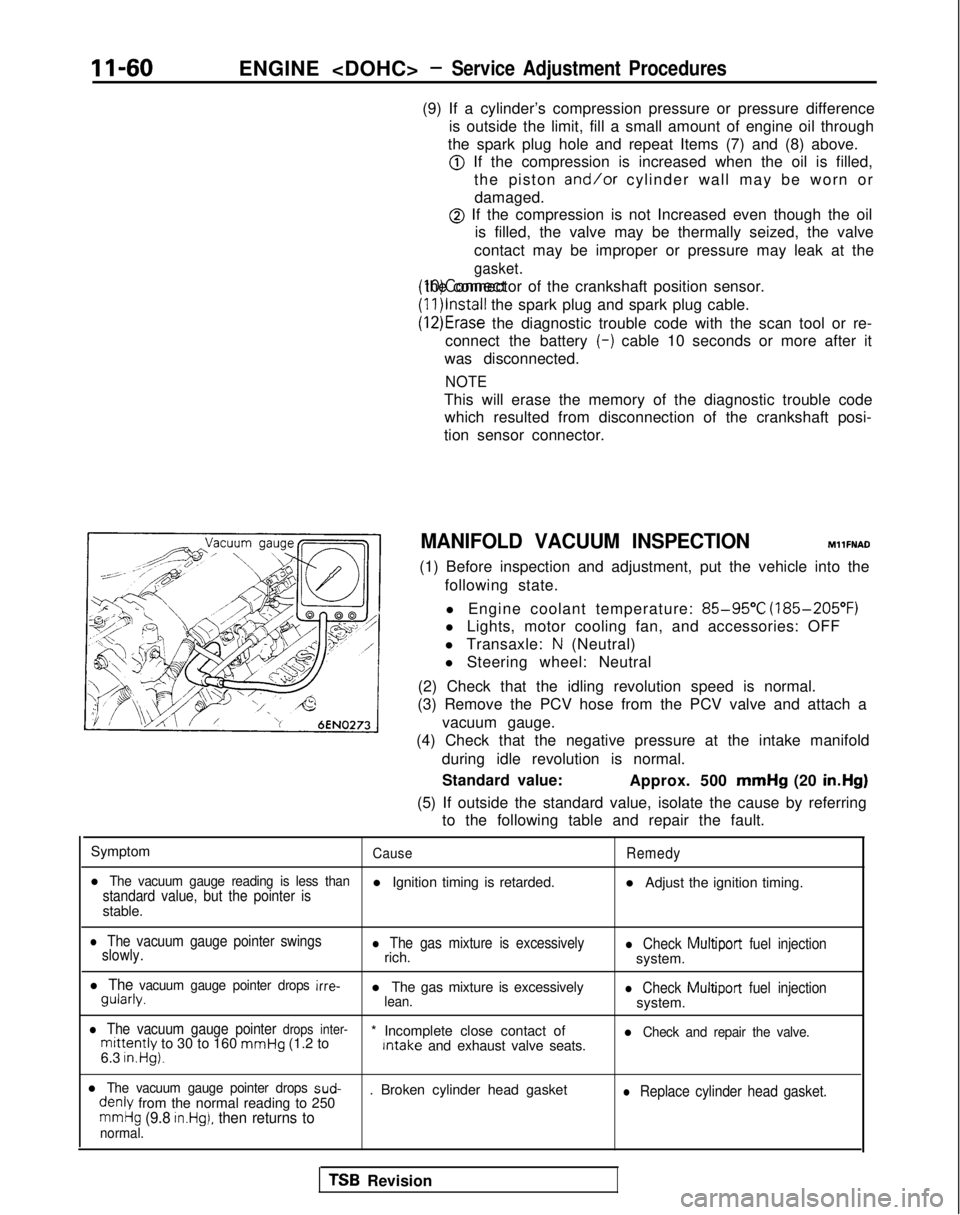1989 MITSUBISHI GALANT oil pressure
[x] Cancel search: oil pressurePage 92 of 1273

11-42
ENGINE
TIMING BELT
REMOVAL AND INSTALLATION
MIlKA-A
Pre-removal Operation
l Removal of under cover
8-10 Nm6-7 ftlbs.
4
’‘\ 50-65
Nm
36-47
ft.lbs.\
IO-12 Nm7-9 ftlbs.
\
\
ft.lbs.’3Q ’23-27 Nm
17-20 ft.lbs.
Removal steps
1.
2.
Clamp for
pressure
hose (power steering)
and high pressure hose (air conditioning) Engine mount bracket
Drive belt (generator) Drive belt (power steering)
Tensioner pulley bracket Drive belt (air conditioning)
Water pump pulley Crankshaft pulley
Timing belt front upper cover
Timing belt front lower cover
Auto tensioner
Timing belt OlA0677
::5.6.
i:9.10.11.
12.
13.14.Tensioner pulley
Tensioner arm
15.
::16.
17.
18.
19.
20.
21.
22.
4*23.
24.
25.
27.
28.
29.
idle pulley
Camshaft sprocket
Oil pump sprocket
Crankshaft sprocket bolt
Special washer Crankshaft sprocket
FlangeTiming belt tensioner “B”
Timing belt “B”
Right silent shaft sprocket Spacer
Kky
Engine support bracket bolt
Timing belt under cover
P
TSB Revision
Page 93 of 1273

ENGINE
+/@Service Adjustment Procedures
24?5
20-;7 Nmio
14-20 ft.lbs.\ is\ i7
Nm50-60 Nm80-94 ft.lbs.36-43 ft.lbs.
Installation steps
29. Timing belt under cover
l +28. Engine support bracket bolt
27. Keyea26. Crankshaft sprocket “6”l +25. Spacer24. Right silent shaft sprocket
22. Timing belt tensioner “B”
l +23. Timing belt
“B”l *Adjustment of timing belt “B” tension1)421. Flangel +20. Crankshaft sprocket19. Special washer
18. Crankshaft sprocket bolt
17. Oil pump sprocket
16. Camshaft sprocket
15. Idle pulley
l al
1. Auto tensioner
14. Tensioner arm 1)+13.
Tensioner pulley
ftlbs.
OlAO682
l +I 2. Timing beltl *Adjustment of timing belt tension
l 41 0. Timing belt front lower cover
I)+ 9. Timing belt front upper cover 8. Crankshaft pulley
7. Water pump pulley
6. Drive belt (air conditioning) (Refer to
P.ll-12.)5. Tensioner pulley bracket
4. Drive belt (power steering) (Refer to
P.l l-l 2.)3. Drive belt (generator) (Refer to P.l l-l 2.)
2. Engine mount bracket
I. Clamp for pressure hose (power steering) and high pressure hose (air conditioning)
TSB Revision
Page 98 of 1273

II-48ENGINE
ChaAfered
Silent shaftnsprocket
Center of
tensioner
pulley
Center of
installation bolt
installation bolt
01Aoo39-
1
25. INSTALLATION OF SPACER
(1) Apply a thin coat of engine oil to the outer circumfer-
ence of the spacer.
(2) Install the spacer with the chamfered end facing the oil
seal.
NOTE
If the spacer is installed adversely, the oil seal may be
damaged, resulting in the oil leaks.
23. INSTALLATION OF TIMING BELT “B”
(1) Ensure that crankshaft sprocket “B” timing mark and the silent shaft sprocket timing mark are aligned.
(2) Fit timing belt “B” over crankshaft sprocket “B” and the silent shaft sprocket. Ensure that there is no slack in
the belt.
. ADJUSTMENT OF TIMING BELT “B” TENSION (1) Temporarily fix the timing belt “B” tensioner such thatthe center of the tensioner pulley is to the left and
above the center of the installation bolt, and temporarily
attach the tensioner pulley so that the flange is toward
the front of the engine.
(2) Holding the timing belt “B” tensioner up with your finger in the direction of the arrow, place pressure on
the timing belt so that the tension side of the belt is
taut. Now tighten the bolt to fix the tensioner.
Caution
When tightening the bolt, ensure that the tensioner
pulley shaft does not rotate with the bolt. Allowing
it to rotate with the bolt can cause excessive
tension on the belt.
(3) To ensure that the tension is correct, depress the belt (point A) with a finger. If not, adjust.
Standard value: 5-7 mm (.20-.28
in.)
TSB Revision1
Page 106 of 1273

1 l-56 ENGINE
SEALANTS AND ADHESIVES
MllCE-B
Items
Semi-circular packing Rocker cover
Oil pressure switch
Engine support bracket bolt
Oil panMITSUBISHI GENUINE PART No.MD970389
or equivalent
Specified sealant 3M
ATD Part No.8660
or equivalent
SPECIAL TOOLSMllDA-8
Tool
NumberNameUse
0 MD998306-01
INSTALLER,
lnstallatlon
of camshaft oil seal
camshaft oil seal
0
Use withM D998307-0 1 MD998307-01
GUIDE, camshaft oil
@
seal
Use with MD998306-01
II
MD998051-01
WRENCH, cylinder
head bolt Tightening of cylinder head to block
OPTIONAL: AVAILABLE FROM O.T.C.
T
GENERALOil pan gasket cutter Removal of the oil pan
r-SERVICE TOOL MD998752-01
Tension pulley
wrench Adjustment of timing belt tension
TROUBLESHOOTING
Refer to P. 1 l-6.
TSB Revision
Page 107 of 1273

ENGINE
OlR0340
7EN0393
1SERVICE ADJUSTMENT PROCEDUBFzo
ENGINE OIL CHECK
(1) Check to ensure that the engine oil level is within the level
range indicated on the oil dip stick.
(2) Check to ensure that the oil is not noticeably dirty or mixed
with coolant or gasoline, and that it has the proper
vtscosity. IASH
ADJUSTERS CHECK
NOTE MllFEAGb
Soon after the engine IS started or while it is running,
abnormal noise (clattering) which may be attributed
to the
adjuster sounds but does not stop. In this case, check the
following.
(1) Check the engine oil, and refill or replace oil if necessary.
NOTE 0
If the oil amount is small, air will be sucked from the oil
strainer and mixed in the oil passage. 0
If the oil amount is excessive, the oil will be stirred by
the crank and mixed with a large amount of air. 0
Air and oil can not be separated easily in the deterio-
rated oil, and the amount of air mixed in the oil
increases.
If such mixed-in air enters the high pressure chamber in
the lash adjuster, the air in the high-pressure chamber will
be compressed while the valve is opened, the lash adjuster
will be excessively compressed and abnormal noise will be produced when the valve is closed.
This is the same phenomenon which occurs when the
valve clearance is improperly adjusted to be excessively
large.
However, it will return to be normal if the air entrapped in
the adjuster is released in this case.
(2) Start the engine, and slowly
race* it several times (10 times
or less). If the abnormal noise is eliminated by racing the engine, it
means that the air is released from the high-pressure
chamber of the lash adjuster and the function of the lash adluster
is returned to normal.
l Gradually increase the engine speed from the idle
speed to 3,000 rpm (for 30 seconds), and then
gradually slow down the engine to the idling speed (for
30 seconds).
NOTE 0
If the vehicle is parked on a slope for a long time, the
oil will be sometimes reduced in the lash adjuster, and
air will enter the high-pressure chamber when the
engine is started.
lAfter the vehicle is parked for a long time, the oil will go
out of the oil passage. Since it takes a little time to
supply oil to the lash adjuster, air sometimes enters the
high-pressure chamber.
TSR Revision
Page 109 of 1273

ENGINE
7 Go;;ikv position
switch
(11)Check that there is continuity between the closed throttle
position switch terminal and body.
NOTE
When there is continuity, a clearance will be created between the throttle lever and dash pot rod when the dash
pot rod is pressed lightly.
(12) When there is no continuity, lower the engine speed when the dash pot begins operation to within the standard value
tolerance. Make sure to create continuity between the
closed throttle position switch terminal and body.
COMPRESSION PRESSURE CHECK Ml 1 FFAL
(1) Before inspection, verify that the engine oil, starter motor
and battery are normal. Then, perform the following.
lEngine coolant temperature: 80- 95°C
(1 76- 205’F)
l Lights, electnc
cooling fan and accessories: OFF
0 Transaxle: P range 0 Steering wheel: Neutral position
(2) Disconnect the spark plug cable.
(3) Remove all the spark plugs.
(4) Disconnect the connector of the crankshaft position sensor.
NOTE
This will prevent the engine control module from controll- ing the ignition and fuel injection.
(5) Cover the spark plug holes with a cloth, etc., and crank the engine. Then verify that no foreign material sticks to the
cloth, etc.
Caution
1.During cranking, be especially careful of the spark plug
installing hole.
2. Very hot water, oil, fuel, etc., which may have entered
the cylinder somehow, will violently spout through the
spark plug hole if the compression is measured in the
entrapped state. This is
vex/ dangerous.
(6) Set up the compression gauge in the spark plug mounting
hole.
(7) Fully open the throttle valve, and cranking the engine.
measure the compression pressure.
Standard value:
kPa (192 psi) [250- 400 rpml
From 1992: 1,550
kPa (220 psi) [250-400 rpm]
Limit:
up to 1991: 960
kPa (137 psi) [250- 400 rpml
From 1992: 1 ,120 kPa (159 psi) [250- 400 rpml
CTurbo>
800
kPa (114 psi) [250- 400 rpml
(8) Measure the compression pressure of each cylinder. and verify that the pressure difference among the cylinders
is
less than the limit value.
Limit: max. 100
kPa (14 psi) TSB Revision
I
Page 110 of 1273

II-60ENGINE
(9) If a cylinder’s compression pressure or pressure differenceis outside the limit, fill a small amount of engine oil through
the spark plug hole and repeat Items (7) and (8) above.
@ If the compression is increased when the oil is filled, the piston
and/or cylinder wall may be worn or
damaged.
@ If the compression is not Increased even though the oil is filled, the valve may be thermally seized, the valve
contact may be improper or pressure may leak at the
gasket. (10)Connect the connector of the crankshaft position sensor.
(1l)lnstall
the spark plug and spark plug cable.
(12)Erase the diagnostic trouble code with the scan tool or re-
connect the battery (-)
cable 10 seconds or more after it
was disconnected.
NOTE
This will erase the memory of the diagnostic trouble code which resulted from disconnection of the crankshaft posi-
tion sensor connector.
MANIFOLD VACUUM INSPECTION MllFNAD
(1) Before inspection and adjustment, put the vehicle into the following state.
l Engine coolant temperature:
85-95°C (185-205°F)
l Lights, motor cooling fan, and accessories: OFF
l Transaxle:
N (Neutral)
l Steering wheel: Neutral
(2) Check that the idling revolution speed is normal.
(3) Remove the PCV hose from the PCV valve and attach a
vacuum gauge.
(4) Check that the negative pressure at the intake manifold
during idle revolution is normal.
Standard value: Approx. 500 mmHg
(20 in.Hg)
(5) If outside the standard value, isolate the cause by referring to the following table and repair the fault.
Symptom
CauseRemedy
l The vacuum gauge reading is less thanstandard value, but the pointer isl Ignition timing is retarded. l Adjust the ignition timing.
stable.
l The vacuum gauge pointer swings
slowly.l The gas mixture is excessivelyrich.l Check Multiport fuel injectionsystem.
l The vacuum gauge pointer drops irre- gularly.
l The gas mixture is excessively
lean.l Check Multiport
fuel injectionsystem.
l The vacuum gauge pointer drops inter-mittently to 30 to 160 mmHg
(1.2 to * Incomplete close contact of Intake
and exhaust valve seats.l Check and repair the valve.
6.3 in.Hg).
l The vacuum gauge pointer drops sud- denly
from the normal reading to 250 . Broken cylinder head gasketl Replace cylinder head gasket.
mmHg (9.8 in.Hg), then returns tonormal.
TSB Revision
Page 116 of 1273

11-66ENGINE
28
29
30
35-45 Nm25-33 ftlbs.
50-65 Nm36-47 ft.lbs.
I
3132
40-50
Nm29-36 ftlbs.
43-56
ft.lbs.
-- .__.. 36-47
ft.lbs.* 54’q
28. z;tFhction for power steering pressure
29. Connection for generator
30. Generator wiring harness clamps
31. Connection for oil pressure switch 4W 1)432.
Connection for power steering oil pump
++ ++33. Connection for air conditioning
compressor
34. Self-locking nut
35. Gasket
36. Bracket
4*37. Engine mount bracket
38. Self locking nut
+e l + 39. Engine assembly
22- 29 ftlbs.c-rurbo>40-60 Nm29- 43 ftlbs.
OlAO405
NOTEFor tightening locations indicated by the l , symbol, firsttighten temporarily, and then make the final tlghtenlng withthe entire weight of the engine applied to the vehicle body.
TSB Revision